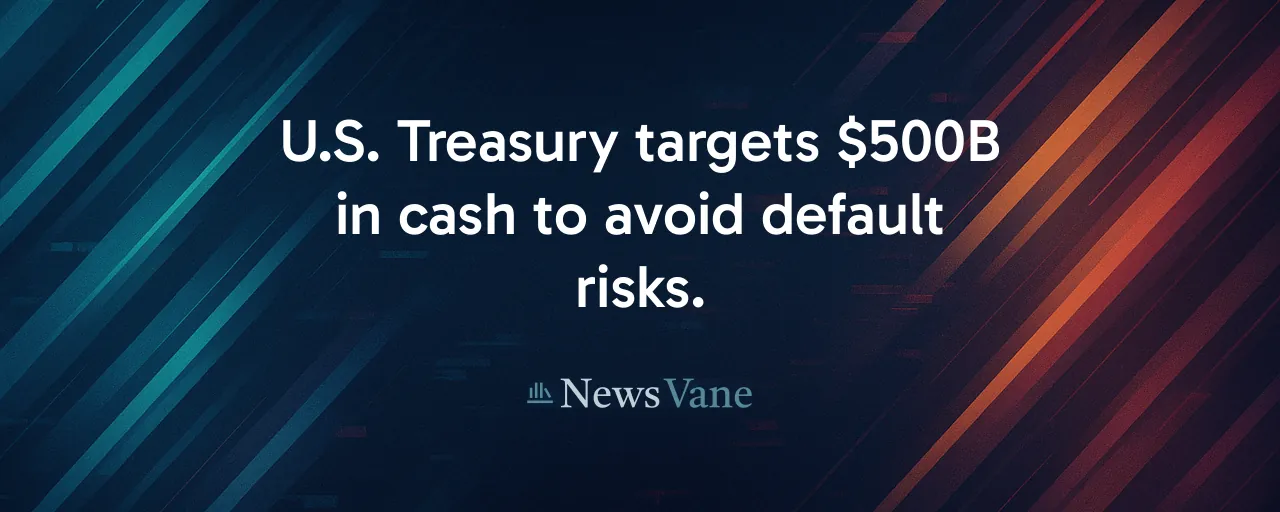A Cash Pile Grows
The U.S. Treasury plans to boost its cash reserves to $500 billion by the end of July 2025, a move that has sparked chatter among investors and policymakers. Fresh off Congress passing the One Big Beautiful Bill Act, which raised the debt ceiling by $5 trillion, the Treasury is acting fast to refill its main checking account, known as the Treasury General Account. This follows months of juggling funds to avoid default, a tactic that left the account at roughly $370 billion earlier this month.
The Treasury's cash pile acts as a critical financial shock absorber, ensuring the government can pay its bills, from Social Security checks to military salaries, without a hitch. But building that buffer requires selling a flood of Treasury bills, which can ripple through markets, nudge interest rates, and even influence how banks lend. The stakes are high, and the effects touch everyone, from taxpayers to global investors.
What's driving this push? The Treasury follows a policy set in 2015, aiming to keep enough cash to cover a week's worth of payments, plus a cushion for emergencies like cyberattacks or natural disasters. The $500 billion target aligns with that rule, but it's not without trade-offs. As the government ramps up borrowing, questions arise about the broader impact on the economy and whether this cash strategy is the best way to keep things running smoothly.
How It Works and Why It's Tricky
The Treasury General Account, held at the Federal Reserve, handles up to $100 billion in daily federal payments. When the debt ceiling is raised, the Treasury issues short-term Treasury bills to rebuild this account. In July 2025, that means selling about $130 billion in new bills, which pulls cash out of banks and money-market funds. This process, while necessary, can tighten liquidity, potentially pushing up short-term interest rates by a small but noticeable amount, perhaps 5 to 15 basis points.
Banks feel the pinch as their reserves at the Fed shrink, which can make lending costlier for businesses and households. Meanwhile, money-market funds and corporate treasurers snap up these bills, seeking safe places to park cash. The Federal Reserve, tasked with keeping monetary policy steady, may need to tweak its tools, like the reverse-repo facility, to manage the sudden demand for collateral. It's a delicate balancing act, and missteps could unsettle markets.
Historically, these cash rebuilds follow a pattern. After debt-ceiling fights in 2011, 2013, 2021, and 2023, the Treasury flooded markets with bills, causing brief spikes in repo rates and bill yields. Research shows these episodes also widen bid-ask spreads, making trading costlier. At the same time, larger cash buffers have lowered the odds of a government default, offering stability that investors and rating agencies value.
Who Wins, Who Waits
A well-stocked Treasury account keeps federal programs humming. Social Security recipients, Medicare providers, federal workers, and contractors all rely on timely payments. By targeting $500 billion, the Treasury reduces the risk of missed checks, especially during crises. This stability also reassures global investors, who hold trillions in U.S. debt and expect the government to honor its obligations without drama.
But there's a flip side. Issuing $130 billion in new bills increases the federal deficit through higher interest payments. Those costs, already the fastest-growing budget item, compete with funding for schools, roads, or healthcare. Plus, draining bank reserves can tighten credit, making loans pricier for small businesses or homebuyers. The effects are subtle but real, and they ripple from Wall Street to Main Street.
Taxpayers, too, have a stake. A larger cash buffer means more borrowing, which adds to the $36 trillion federal debt. While this ensures short-term solvency, it doesn't address long-term fiscal challenges. Studies suggest that debt-ceiling uncertainty itself raises borrowing costs, costing taxpayers billions over time. A smoother process could save money, but that requires changes beyond just cash management.
Looking Back to Move Forward
The debt ceiling has been a political flashpoint since 1917, when it was created to streamline war-bond sales. Since then, Congress has raised or suspended it over 100 times, often with last-minute deals. Crises in 2011 and 2023 led to credit-rating downgrades and market sell-offs, while 2013 triggered a government shutdown. Each time, the Treasury rebuilt its cash pile afterward, learning that bigger buffers reduce panic but amplify market swings.
Academic research backs this up. Studies show that debt-ceiling standoffs disrupt Treasury bill markets, depress issuance before a deal, and flood markets after. Since 2015, when the Treasury adopted its current cash policy, these swings have grown but defaults have become less likely. Experts agree that sufficient cash is vital for solvency, but they also warn that long-term debt sustainability hinges on fiscal reforms, not just bigger cash piles.
Finding Common Ground
The Treasury's plan to hit $500 billion by July 2025 is a practical step that addresses immediate needs, but it does not resolve all underlying issues. Lawmakers could ease tensions by replacing the debt ceiling with a mechanism that automatically allows borrowing for approved spending. Another idea is setting a flexible cash target, say, $250 billion to $500 billion, reviewed yearly by experts. These changes would keep payments flowing while addressing concerns about unchecked borrowing.
A bipartisan fiscal commission could also help, tasked with proposing deficit cuts if debt-to-GDP ratios climb too high. Automatic continuing resolutions could prevent shutdowns, removing the debt ceiling as a bargaining chip. These ideas aim to balance stability with accountability, ensuring the government meets its obligations without fueling endless debt or market chaos.
Ultimately, the Treasury's cash strategy is about trust, in markets, in government, and in the systems that keep the economy moving. By prioritizing clear communication and predictable bill issuance, the Treasury can minimize disruptions. For taxpayers, workers, and investors, that trust translates into payments arriving on time, markets staying calm, and a government that functions, even in turbulent times.
